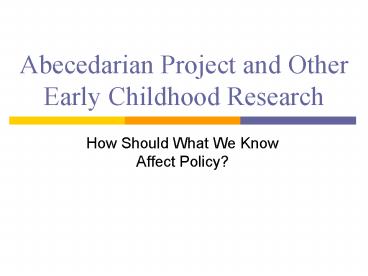Abecedarian Project and Other Early Childhood Research - PowerPoint PPT Presentation
1 / 18
Title:
Abecedarian Project and Other Early Childhood Research
Description:
Benefits of high-quality educational child care were apparent in early adulthood ... Eliminate duplicative and ineffective programs. Link future funding to performance ... – PowerPoint PPT presentation
Number of Views:235
Avg rating:3.0/5.0
Title: Abecedarian Project and Other Early Childhood Research
1
Abecedarian Project and Other Early Childhood
Research
- How Should What We Know Affect Policy?
2
Key Findings from Abecedarian Project(Abecedaria
none who learns the basics such as the alphabet)
18 Months to 21 Years Old
- Intelligence (IQ)
- Reading and Math Skills
- Academic Locus-of-Control
- Social Competence
- Years in School, Including College
- Full-time Employment
- Grade Repetition
- Special Education Placement
- Teen Pregnancies
- Smoking and Drug Use
Plus benefits to mothers of these children
(education, employment)
-Ramey et al, 2000
3
Conclusions
- Benefits of high-quality educational child care
were apparent in early adulthood - More years of education attained
- Greater academic skills in reading and math
- Greater likelihood of being in school
- More likely to attend a 4-year college
4
Conclusions
- Delayed childbearing
- Increased likelihood of being employed
- Greater degree of economic independence
- No differences in criminal involvement
5
The Bottom Line
- Significant long-term benefits were associated
with high quality early childhood education. - The likelihood of either working or being in
school at age 21 was doubled for individuals
treated in infancy and preschool.
6
The Future for Our Nations Children
- Positive educational outcomes can be achieved for
all children during pre-K years and beyond - Reading success is a key, because of strong
linkages to all learning and social adjustment - Strategic investments yield substantial social
and fiscal benefits to society (at least 1-to-4
costbenefit ratio)
7
Policy Implications
- Learning begins in infancy, education must also.
- The educational stimulus value of the early care
giving years must not be wasted. - Welfare reform has increased the need for early
child care. We must not lose the opportunity to
provide poor children the early learning that can
lead to later success.
8
Policy Recommendations
- Establish comprehensive early childhood
educational initiatives that are linked
explicitly to K-12 learning and achievement - Targeted for high risk children
- Grounded in scientific evidence
- Builds upon existing resources
9
Policy Recommendations
- Design and implement a strong accountability
system that continuously monitors program quality
and documents child progress and outcomes - To inform quality improvements
- To strengthen training and technical assistance
- To reward performance
10
Policy Recommendations
- Combine Funding Streams
- Promote Innovative Partnerships
- Strengthen Existing Programs That Serve Children
From Prenatal Care Through Age 5
11
Braided Funding Initiatives
Braided Funding Streams to Enhance Head Start/EHS
Percentages based on 2002 revenues
12
Policy Recommendations
- Offer strong incentives for collaboration
- Eliminate duplicative and ineffective programs
- Link future funding to performance
13
What is Smart Start?
- North Carolinas early childhood initiative for
children birth through 5 and their families - Goal is to help all children enter school healthy
and ready to succeed - Public-private partnership
- Comprehensive, community-based
- Providing high-quality child care, health care
and family services - Local determination (with guiding principles)
- Variety of efforts that vary by county and by year
14
What Smart Start Is Not
- A single, easily defined intervention
- An intervention with a single goal or population
to serve - A longitudinal study of specific children
- A program in a vacuum
15
How Does Smart Start Work?
- Funding from Legislature to NC Partnership for
Children - 24 million in 1993 to 190 million in 2003
- From NCPC to 82 local partnerships
- Partnerships fund contract providers
16
Theories of Change Underlying Smart Start
17
Smart Start Outcomes
Quality of NC Preschool Child Care
of Centers
Classroom Quality
18
Smart Start Outcomes
Percent































